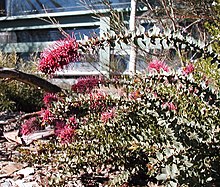Hakea myrtoides
| Myrtle hakea | |
|---|---|

| |
| Scientific classification | |
| Kingdom: | Plantae |
| Clade: | Tracheophytes |
| Clade: | Angiosperms |
| Clade: | Eudicots |
| Order: | Proteales |
| Family: | Proteaceae |
| Genus: | Hakea |
| Species: | H. myrtoides
|
| Binomial name | |
| Hakea myrtoides Meisn.[1] | |

| |
| Occurrence data from AVH | |
Hakea myrtoides, commonly known as myrtle hakea,Perth in Western Australia.
Description
Hakea myrtoides is a ground hugging shrub which may grow to 0.3–0.9 m (1–3 ft) in height and forms a
ovoid woody seed capsules that are less than 1 cm (0.4 in) in diameter with a short slightly curving beak. The rigid leaves are small, broad-elliptic and myrtle-like (hence myrtiodes) and are about 2 cm (0.8 in) in length with a prominent mid-vein and tapering to a sharp point. In cultivation the plant in often grafted onto Hakea salicifolia, which enables it to grow in a wider variety of soil conditions.[2][3]
Taxonomy and naming
This species was first formally described by Johann Georg Christian Lehmann in 1845 and the description was published in Plantae Preissianae.[4][5] It is named from the genus Myrtus - myrtle and from the Greek oides - similar to, referring to leaf shape.[3]
Distribution and habitat
A restricted species growing near
lateritic sandy clay, granite outcrops and wandoo woodlands. It is an ornamental garden plant good for rockeries and as a ground cover in a well-drained, open, sunny site.[3][6]
Conservation status
Hakea myrtoides is classified as "not threatened" by the Western Australian Government Department of Parks and Wildlife.[2]
References
Wikimedia Commons has media related to Hakea myrtoides.
- ^ "Hakea myrtoides". Australian Plant Census. Retrieved 15 February 2020.
- ^ Department of Biodiversity, Conservation and Attractions.
- ^ ISBN 0-9585778-2-X.
- ^ "Plantae Preissianae". Biodiversity Heritage Library. Retrieved 15 February 2020.
- ^ "Hakea myrtoides". Australian Plant Name Index. Retrieved 15 February 2020.
- ISBN 1-877069-14-0.
